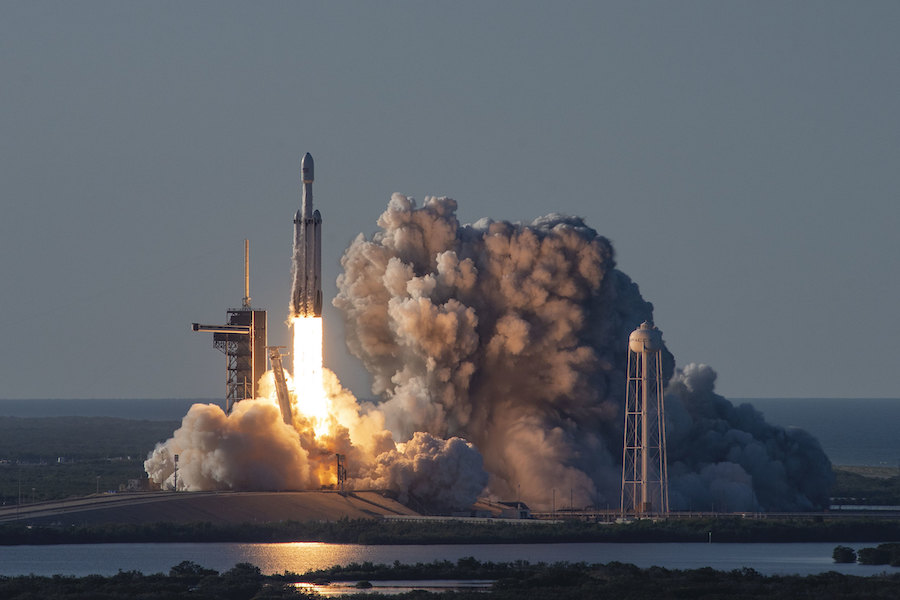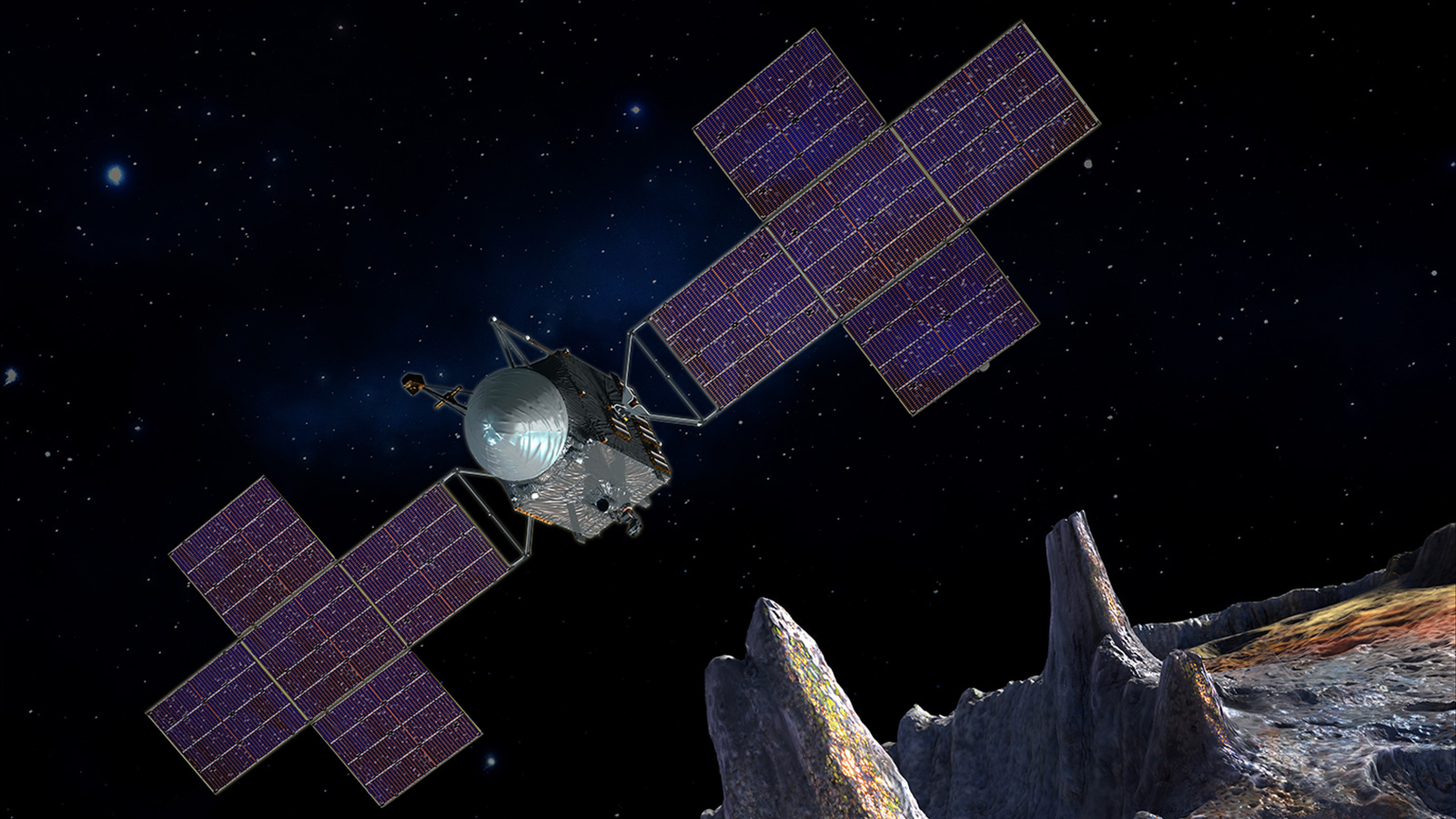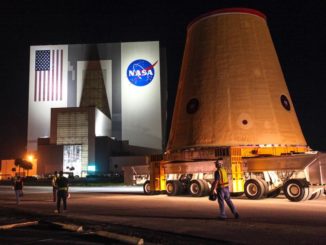
NASA has selected SpaceX’s Falcon Heavy rocket to launch a robotic mission in July 2022 to explore Psyche, a metal-rich asteroid located between the orbits of Mars and Jupiter. The Psyche probe is NASA’s first mission assigned to fly on SpaceX’s heavy-lift launcher.
A Falcon Heavy rocket, formed by combining three SpaceX Falcon 9 rocket boosters together, will launch the Psyche mission and two smaller NASA science probes from pad 39A at NASA’s Kennedy Space Center in Florida.
SpaceX and United Launch Alliance were eligible to launch the Psyche mission, and NASA officials selected SpaceX’s Falcon Heavy for the job. NASA announced the launch contract — valued at $117 million — in a press release Friday.
The contract value includes the launch service and other mission-related costs, according to NASA.
SpaceX’s Falcon Heavy proposal was believed to be competing against a ULA bid to launch Psyche on an Atlas 5 rocket.
In a tweet, SpaceX wrote that NASA “requires the highest level of launch vehicle reliability” for the Psyche mission.
With the Psyche launch contract awarded by NASA, SpaceX has confirmed at least four missions in its backlog booked on Falcon Heavy rockets — one each for the U.S. Space Force, the National Reconnaissance Office, NASA and Viasat. Inmarsat, a London-based commercial satellite operator, also has a contract option to launch a future mission on a Falcon Heavy vehicle.
“We are super excited to have a launch vehicle,” said Lindy Elkins-Tanton, the Psyche mission’s principal investigator from Arizona State University.
Scientists and engineers were designing the spacecraft to be “agnostic” to the launch vehicle NASA selected for the mission, Elkins-Tanton said in an interview with Spaceflight Now.
“We were being agnostic and trying really hard to capture the shock and vibe (vibration) envelopes of either vehicle and make sure that everything would be OK either way,” she said. “We got lots of good support and help to do that, but it’s always much better to have only just one design that you’re working on.”
The Falcon Heavy rocket is the most powerful launcher currently in operation, with 27 Merlin engines producing some 5.1 million pounds of thrust at liftoff. SpaceX has successfully launched three Falcon Heavy missions since 2018, and a fourth flight is scheduled in late 2020.
NASA selected the Psyche mission for development in January 2017, along with a robotic mission named Lucy to fly by seven asteroids. Lucy will explore objects locked in orbits leading and trailing Jupiter, where scientists expect swarms of miniature worlds could hold clues about the formation of the solar system.
NASA announced last year that Lucy will lift off from Cape Canaveral in October 2021 aboard a United Launch Alliance Atlas 5 rocket. The Atlas 5 contract is valued at $148 million.
A space agency spokesperson said the Falcon Heavy rocket that will launch the Psyche mission will use all-new boosters, rather than previously-flown hardware recovered from earlier missions.
Lucy and Psyche are the 13th and 14th missions selected in NASA’s Discovery program, which manages a series of cost-capped planetary science missions. The cost of the Lucy and Psyche missions is limited to $450 million for each project, but the launch vehicle is not counted in the cost cap.
Maxar, formerly known as Space Systems/Loral, is building the Psyche spacecraft.
Elkins-Tanton said NASA’s choice of SpaceX’s Falcon Heavy rocket adds a “little shine” of extra excitement to the mission.
“Two things really excite me about it especially,” she said. “One is that from the beginning we’ve been trying to make this mission a step into the blended future of ‘New Space,’ plus ‘Old Space,’ plus NASA, doing big things together.
“So bringing Maxar in — that was a new partner for deep space for NASA at the time — and then working with a ‘New Space’ company on the rocket launch is kind of continuing on that pathway that we’re trying to do, to continue marching into the future,” she said. “Part of that is also our big attempts at major student collaborations and outreach, and I cannot imagine that flying on a Falcon Heavy is going to hurt our outreach efforts.”
She said mission managers are convening a series of design reviews for the Psyche mission’s systems and instruments before a mission-level critical design review in May, when engineers will confirm the final design of the spacecraft.
In the meantime, production of the chassis of the Psyche spacecraft has started at Maxar, which will assemble the probe at a facility in Palo Alto, California.
“We’ve seen parts of the chassis, and that is incredibly exciting after all these years of planning,” Elkins-Tanton said. “Our idea for this mission started in 2011, so here we are nine years later seeing our first bits of flight hardware. It’s actually pretty breathtaking.”
The Psyche mission will launch in July 2022 from Florida’s Space Coast and reach Mars in May 2023, where it will use the planet’s gravity to slingshot into the asteroid belt. The spacecraft is scheduled to arrive at asteroid Psyche in January 2026, then orbit the metallic world for 21 months.
The asteroid is about the size of Massachusetts and has an irregular shape. It completes one rotation every 4.2 hours.
Observations of Psyche through telescopes suggest the asteroid is composed largely of nickel-iron metal, suggesting the asteroid could be the leftover core from the building block of a planet, or planetesimal, in the early solar system more than 4 billion years ago.

“When we wrote the proposal, we and most of the science community were pretty sure that Psyche was maybe 90 percent metal on its surface,” Elkins-Tanton said. “And the only way we could ever imagine that a body like that could be made was by collisional stripping of the rocky exterior off of that metal core of a very, very early tiny planet called a planetesimal.”
These early building blocks of planets formed a metal core and a rocky exterior in the first few million years of the solar system, according to Elkins-Tanton.
With scientific interest in Psyche ramping up as NASA prepares to send a probe to the asteroid, researchers are re-evaluating their preliminary conclusions. No spacecraft has ever explored a metallic asteroid up-close.
“What we did is we took all of the existing data about the asteroid Psyche — the whole science team worked on this for about 10 months — and tried to look at the data from every point of view,” Elkins-Tanton said.
Scientists compared the data on Psyche with meteorites that have fallen to Earth, along with planetary formation models and other asteroids.
“And what we’re finding is that it looks like, the current data seems to indicate, that Psyche is potentially less metallic than we thought it was originally,” Elkins-Tanton said. “It might just be 30 to 60 percent metal, instead of 90 percent metal. Maybe to any sensible person that would seem to be relatively unimportant, but in terms of how we think it might have been made, it makes it much more confusing.
“How you get something that’s more or less a half-and-half mixture of metal and rock on this scale is actually much weirder,” she said. “So to a lot of us this makes it much more exciting. Now we know less about what Psyche is than we thought we knew a few years ago, and the only way we’re going to answer this mystery is by going there. So it makes even more motivating.”
Secondary payloads to hitch a ride with Psyche
NASA plans to send two smaller science probes into space with Psyche aboard the Falcon Heavy rocket in 2022, pending final mission reviews.
One of the missions, named Janus, will launch two microsatellites to fly by two binary asteroid systems, which consist of a pair of objects orbiting one another. The Janus team is led by Daniel Scheeres of the University of Colorado, and Lockheed Martin will build and operate the two Janus spacecraft — each about the size of a suitcase — as they head for their asteroid targets.
The Janus spacecraft will carry visible and infrared imagers to survey the binary asteroid systems.
The binary asteroids are “so small that you could actually jump from one body to the other body in space,” Scheeres said. “No one’s studied them up close before, so Janus will be the first to do this, and it’s going to give us insight into the formation of the solar system, how the solar system has evolved up to the current day, and is still evolving.”
“We are very excited by the selection of the launch vehicle, as it allows us to complete many of our engineering designs,” he wrote in an email to Spaceflight Now.
The other mission slated to accompany the Psyche mission into space is the Escape and Plasma Acceleration and Dynamics Explorers, or EscaPADE, mission.
Like Janus, EscaCAPE consists of two smallsats. But instead of targeting asteroids, the EscaPADE probes will fly to Mars to study how the solar wind is driving molecules out of the Martian atmosphere and into space.Building on NASA’s MAVEN mission, which has orbited Mars since 2014, the EscaPADE smallsats would carry science instruments to measure magnetic fields, plasma, ion densities and electron flows around Mars. Unlike MAVEN, which is a single satellite, the EscaPADE mission would simultaneously measure the environment around Mars from two different locations.
The principal investigator for EscaPADE is Robert Lillis from the University of California, Berkeley.
Grey Hautaloma, a NASA spokesperson, said the final approval of the Janus and EscaPADE missions is pending review and final selection.
Janus and EscaPADE are two of three missions selected for further study by NASA last year through the Small Innovative Missions for Planetary Exploration, or SIMPLEx, program. The SIMPLEx program aims to advance development of a new class of lower-cost small interplanetary science probes to launch as rideshare payloads on the same rocket with larger missions.
The SIMPLEx missions are cost-capped at $55 million, excluding launch costs.
The other SIMPLEx mission under evaluation is Lunar Trailblazer. That mission is designed to launch as a secondary payload with an unidentified geostationary satellite, then head into lunar orbit to map water on the moon.
Email the author.
Follow Stephen Clark on Twitter: @StephenClark1.



